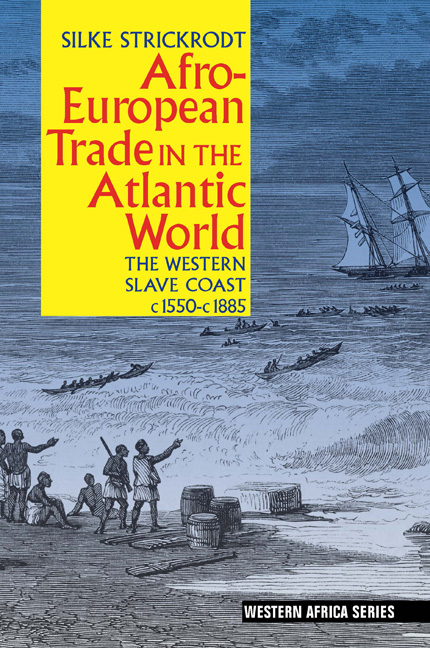Book contents
- Frontmatter
- Dedication
- Contents
- List of Maps
- List of Abbreviations
- Acknowledgements
- Map
- Introduction
- 1 The regional setting
- 2 The Atlantic connection: Little Popo & the rise of Afro-European trade, c.1600 to 1702
- 3 The era of the warrior kings: 1702 to 1772
- 4 The era of the traders: 1772 to c.1807
- 5 Disintegration & reconstitution: Political developments, 1820s to 1870s
- 6 From slaves to palm oil: Afro-European trade, c.1807 to 1870s
- Epilogue: The colonial partition & its consequences, 1870s to c.1900
- Bibliography
- Index
2 - The Atlantic connection: Little Popo & the rise of Afro-European trade, c.1600 to 1702
Published online by Cambridge University Press: 05 May 2015
- Frontmatter
- Dedication
- Contents
- List of Maps
- List of Abbreviations
- Acknowledgements
- Map
- Introduction
- 1 The regional setting
- 2 The Atlantic connection: Little Popo & the rise of Afro-European trade, c.1600 to 1702
- 3 The era of the warrior kings: 1702 to 1772
- 4 The era of the traders: 1772 to c.1807
- 5 Disintegration & reconstitution: Political developments, 1820s to 1870s
- 6 From slaves to palm oil: Afro-European trade, c.1807 to 1870s
- Epilogue: The colonial partition & its consequences, 1870s to c.1900
- Bibliography
- Index
Summary
In the seventeenth century, the western Slave Coast was transformed by two interrelated developments; first, the development of European trade on this section of the coast and, second, the immigration and settlement of Gold Coast people in the region.
In 1471, the Portuguese arrived on the Gold Coast, which they called Costa da Mina, and started trading for gold there. In the following year, they began charting the coast to the east of the Volta river. Initially, however, they showed little interest in exploring the commercial potential of the region that was to become the Slave Coast. Their focus was on the gold trade on the Costa da Mina and the commercial relations which they established elsewhere in West Africa were developed mainly in order to further this trade. Thus, slaves purchased in the kingdom of Benin (in today's Nigeria), where the Portuguese traded by the 1480s, were re-sold on the Costa da Mina in exchange for gold. Moreover, the forbidding conditions of the sea on the Slave Coast probably acted as a deterrent to any attempt to establish contacts with the people there. When they eventually did become interested in the Slave Coast, it was the outlets of the rivers and the lagoon into the sea which they explored. First they investigated the Lagos channel at the eastern end of the Slave Coast, which was evidently successful because through it they established contact with the kingdom of Ijebu. In 1530 their attention turned to the Volta on the western end of the Slave Coast, following reports that interlopers threatened the royal monopoly of the gold trade. This too was successful, and trade was established there soon afterwards, probably by 1536. The only other riverine outlet on the Slave Coast was the Bouche du Roi, which attracted the interest of the Portuguese in 1553, when a trade embargo with Benin prompted them to look elsewhere for alternative sources of slaves. However, the initial attempt to establish contact with the people on ‘the river which is called the Papoues’ was reported to have failed due to ‘the bad management of those who went there’.
- Type
- Chapter
- Information
- Afro-European Trade in the Atlantic WorldThe Western Slave Coast, c. 1550–c.1885, pp. 65 - 101Publisher: Boydell & BrewerPrint publication year: 2015

